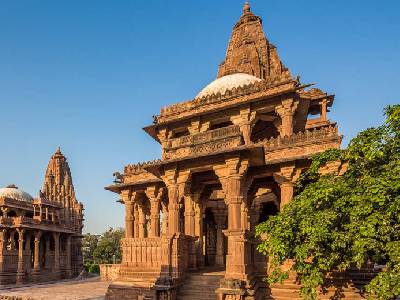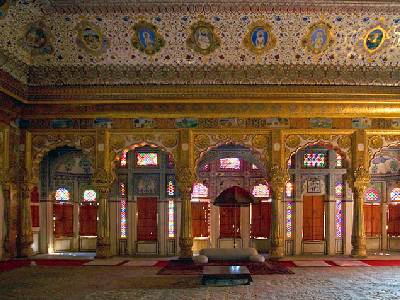Jodhpur Sightseeing Tour Packages
Jodhpur, the second-largest city in Rajasthan is popularly known as the Blue City. The name is clearly befitting as most of the architecture – forts, palaces, temples, Havelis, and even houses are built in vivid shades of blue. The strapping forts that tower this magnificent city sum up to a spectacle you would not want to miss. The mammoth, imposing fortress of Mehrangarh has a landscape dominating a rocky ridge with the eight gates leading out of the fortress. The new city is located outside the structure. Jodhpur is also known for the rare breed of horses known as Marwari or Malani, which are only found here.Atithi Cabs offers Sightseeing Taxi service in Jodhpur with all new ac cabs fare starts from 1600Rs. only.
As the leading cab service provider in the region, we specialize in creating unforgettable travel experiences with our top-notch Jodhpur Tour Packages, luxurious Jodhpur sightseeing taxi services, and the most reliable tempo traveller rentals in Rajasthan.

Why Atithi Cabs is the Best Choice for Your Jodhpur Sightseeing Tour?
Iconic Landmarks of the Blue City
With years of experience in the travel industry, Atithi Cabs has become synonymous with quality and trust. We understand every corner of Jodhpur, ensuring you experience the city’s rich heritage and vibrant culture in the most authentic way possible.
Diverse Jodhpur Tour Packages
From budget-friendly options to luxurious experiences, our Jodhpur Tour Packages cater to all types of travelers. Whether you want a quick half-day city tour or a detailed multi-day exploration, we customize the perfect itinerary for you.
Luxury Jodhpur Sightseeing Taxi Services
Our fleet of well-maintained vehicles ensures you travel in style and comfort. Choose from sedans, SUVs, and premium cars, all available at competitive prices. Our professional drivers are not just chauffeurs but also your friendly local guides, making every Jodhpur sightseeing taxi ride a delightful experience.
Best Tempo Traveller in Rajasthan
Traveling with a group? Atithi Cabs offers the most reliable tempo traveller services in Rajasthan.
With spacious seating, air-conditioned comfort, and modern amenities, our tempo travellers are perfect for family vacations, corporate tours, and group outings.
What Sets Atithi Cabs Apart from the Rest?
- Affordable Luxury: We combine premium services with budget-friendly pricing, ensuring every traveler enjoys a royal experience.
- Tailored Packages: Our custom-designed Jodhpur Tour Packages allow you to choose attractions and activities based on your preferences.
- Safety First: With GPS-enabled vehicles, experienced drivers, and rigorous safety measures, your safety is always our priority.
- Eco-Friendly Travel: We are committed to sustainable tourism practices, ensuring a greener future for Rajasthan. .
Explore Rajasthan in Comfort with Our Tempo Traveller Services
Beyond Jodhpur, Atithi Cabs extends its impeccable service across Rajasthan. Our tempo traveller rentals in Rajasthan are ideal for group tours to destinations like Jaipur, Udaipur, Jaisalmer, Mount Abu, and more.
Why Choose Our Tempo Traveller Services?
- Spacious Interiors: Comfortable seating for up to 12, 15, or 18 passengers.
- Modern Amenities: Fully air-conditioned, ample luggage space, and entertainment systems for long journeys.
- Professional Drivers: Courteous and skilled drivers with in-depth knowledge of Rajasthan’s routes.
- Affordable Group Travel: Share costs among your group for an economical yet luxurious travel experience.
From weddings and family functions to corporate tours and weekend getaways, our tempo travellers redefine group travel in Rajasthan.
Book Your Jodhpur Sightseeing Tour Today!
Don’t miss the chance to explore Jodhpur and Rajasthan in the most convenient and luxurious way possible. Whether you need a Jodhpur sightseeing taxi, a customized Jodhpur Tour Package, or the best tempo traveller in Rajasthan, Atithi Cabs is your trusted travel partner.
Experience the best of the Blue City with Atithi Cabs – where every journey is royal and every memory is priceless. Call us today to book your next adventure!
Top Trending Jodhpur Holiday Destinations

Mehrangarh Fort
Rising perpendicular and impregnable from a hill which is 125 metres above Jodhpur’s skyline is the Mehrangarh Fort. This historic fort is one of the most famous in India and is packed with history and legends.

Khejarla Fort
Located 85 kilometres from the main city, the 400-year old Khejarla Fort is situated in a rural setting. The stunning red sandstone monument, now a hotel, is an example of Rajput architecture.

Umaid Bhawan Palace
Umaid Bhawan Palace was built by Maharaja Umaid Singh in 1929 to counter a famine which had hit the state at the time. It was also known as the Chittar Palace while being constructed thanks to the use of stones drawn from the Chittar hill.

Moti Mahal
Moti Mahal, as the name suggests, is the Pearl Hall where the royal families held their audience. The hall is known to have glass windows and five nooks that enabled the queens to listen to the proceedings taking place in the Sringar Chowki.

Mandore
This area is of major historical importance and you will find the dewals or cenotaphs of Jodhpur’s former rulers. Unlike the original chhatri-shaped cenotaphs that are typical patterns of Rajasthan architecture, these are built along the lines of Hindu temples.

Phool Mahal
Going by the name, the Phool Mahal or Flower Hall is the most exorbitant of all the halls in the palace. This beautiful chamber is said to be the pleasure dome for the Maharajas. The gold used for constructing the Mahal came from Ahmedabad, Gujarat.

Chamunda Mataji Temple
Chamunda Mataji was Rao Jodha’s favourite goddess and so her idol was bought to the Mehrangarh Fort. Thus, the fort became a place of worship and was turned into a temple. Since then, locals have followed the culture of worshipping Chamunda Mata.

Ranisar Padamsar
Located near the Fateh Pole in Mehrangarh, the Ranisar and Padmasar are adjacent lakes that were constructed in the year 1459. Ranisar Lake was built on orders of Queen Jasmade Hadi, Rao Jodha's wife while Padmasar Lake was ordered by Queen Padmini of Rao Ganga, daughter of Rana Sanga of Mewar.

Jaswant Thada
This milky white memorial built towards the end of the 19th century as a tribute to the leader Jaswant Singh is a huge tourist attraction. Jaswant Singh, who ruled Jodhpur, invested well in his state.

Ghanta Ghar
Ghanta Ghar, also known as the clock tower of Rajasthan, is situated in one of the busiest areas of Jodhpur, the Sadar Bazaar. It was constructed by Shri Sardar Singh Ji of Jodhpur.

Mahamandir Temple
Mahamandir, meaning great temple, is a sanctified spot where tranquillity reigns supreme. Situated on Mandore road, the temple is an architectural wonder.

Masuria Hills
Masuria garden is one of the three most beautiful and famous gardens of Rajasthan. Located on top of the Masuria hill in the middle of Jodhpur, it is popular among devotees because of the centuries-old temple dedicated to a local deity, Baba Ramdev.
